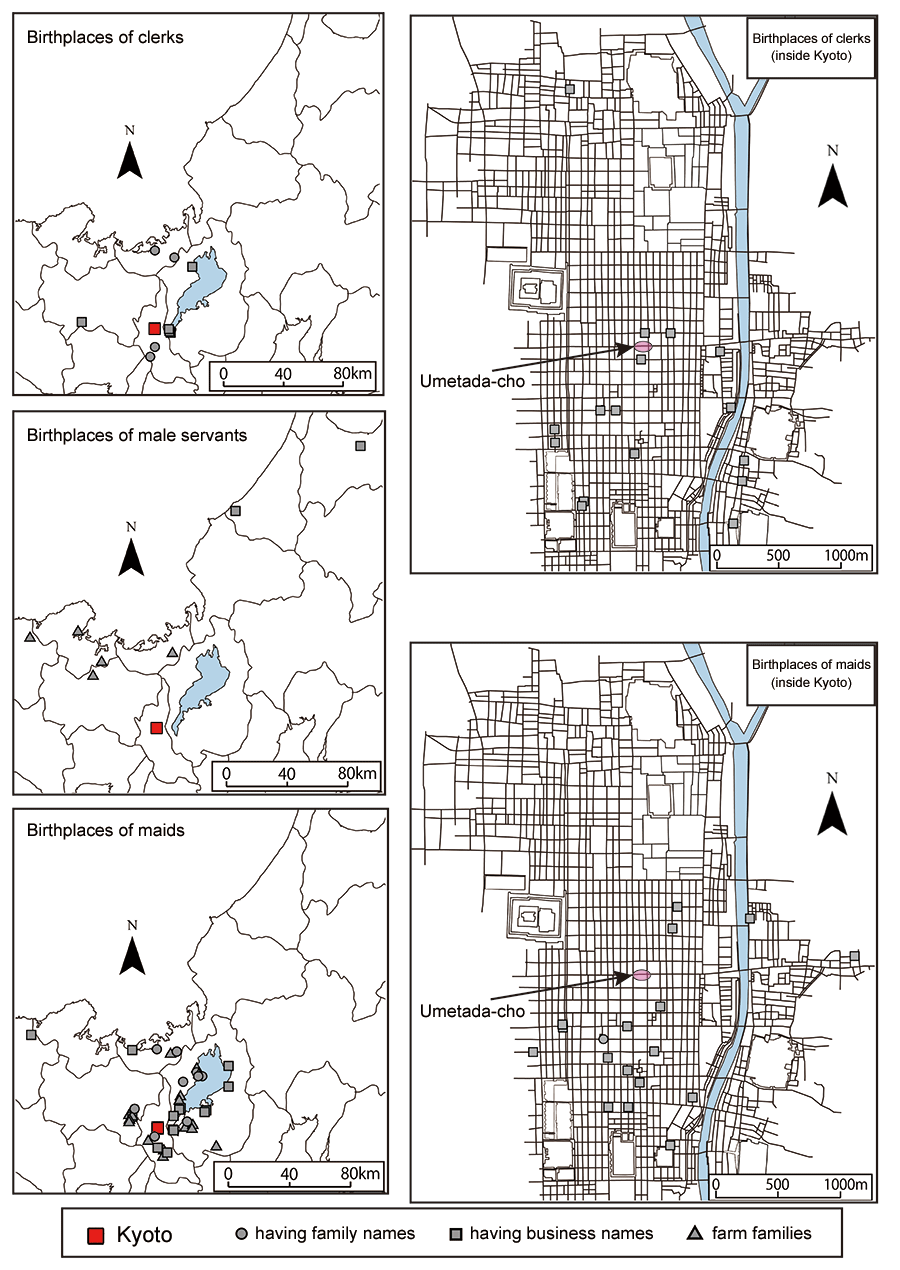 |
Distribution of the birthplaces of the Endo household employees. |
— Merchants and their Employees —
After the Tokugawa shogunate began in 1603 at Edo (modern-day Tokyo), Edo became the de facto capital and the largest city in Japan. Nonetheless, Kyoto continued to be the Imperial seat, and, at the time, Osaka emerged as the center of the domestic trade. Accordingly, Edo, Kyoto, and Osaka were called “the Three Capitals.” Not only the Imperial seat, Kyoto had also been the center of fine manufacturing such as silk products and their trade. Therefore, many merchants, wealthy and small, gathered in Kyoto. While Nishijin district (northwestern part of Kyoto) specialized in silk manufacturing, Shimogyo district (downtown, namely the area around Shijo-Karasuma) formed the business district. Several wealthy merchants, who operated their huge retail shops in Edo, kept their headquarters in Kyoto. The following are the research results based on the documents concerning employment contracts and guarantees kept in the Endo household known by the business name of Hiranoya.
The Endo household was a merchant household of textile products having its shop in Umetada-cho, a street segment along Sanjo street between the crossing with Karasuma and Higashinotoin streets. They started their business in the middle of the seventeenth century and grew to employ 20 or 30 live-in personnel by the middle of the nineteenth century. Their live-in employees were classified into (1) clerks and their trainees, (2) male servants, and (3) maids. The clerks and trainees worked in the shop along the street, while servants and maids worked in the master’s house. Clerks served predetermined terms of about 20 years and, at the end of their service, were given a chance to establish their own shops. In contrast, male servants and maids had short-term employment contracts of about one year and no possibility of independence. These practices, which distinguish employees according to their position, were shared by major merchants.
 |
Distribution of the birthplaces of the Endo household employees. |
The above pictures show the distribution of the birthplaces of the employees of the Endo household in the middle of the nineteenth century. The data used are documents of the employment contracts containing the information of the name, occupational position, term of service, and birthplace of the employee, and the name and address of the guarantor. As for the clerks, most were from Kyoto and its surrounding areas. Specifically, many clerks were from families in Shimogyo and had business names (yago). Since Shimogyo was the business district, it is supposed that they were from merchant households. Merchants in Shimogyo formed a trade association; so the Endo household might have used the connection within the association to employ clerks. In many cases, clerks from provinces outside Kyoto had family names (myoji). Because in the Edo period commoners were not permitted to have family names, clerks having family names were most likely from families of high social status. Conversely, many of the male servants were employed from remote northern provinces. As for their social status, they were most likely from not so wealthy farming families (hyakusho) and came to Kyoto in search of work. Many of the maids were employed from the Yamashiro (in which Kyoto is located) and Omi (modern-day Shiga prefecture) provinces. This spatial pattern could be related to the fact that these provinces formed Kyoto’s sphere of influence. They came from various social statuses including family name holders (high rank), business name holders (merchants), and farming families. However, their jobs are considered to have been differentiated according to their social rank.
According to the analyses mentioned above, business in Kyoto in the nineteenth century was carried out by people from families from various social statuses in various regions. However, nobody from the southward and southeastward provinces, namely Yamato (Nara prefecture), Kawachi, and Settsu (Osaka Prefecture), was employed by the Endo household. This directional bias could be seen as reflecting Osaka’s sphere of influence.
By Yuki Nagashima (Saitama University) and Noboru Ogata (Emeritus, Kyoto University)
See also...
| Since : March 30, 2018 | Last updated : May 11, 2023 |